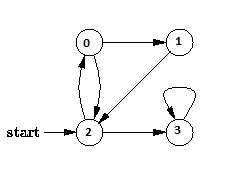Theoretical Paper
- Computer Organization
- Data Structure
- Digital Electronics
- Object Oriented Programming
- Discrete Mathematics
- Graph Theory
- Operating Systems
- Software Engineering
- Computer Graphics
- Database Management System
- Operation Research
- Computer Networking
- Image Processing
- Internet Technologies
- Micro Processor
- E-Commerce & ERP
Practical Paper
Industrial Training
Breadth First Traversal for a Graph
Breadth First Traversal (or Search) for a graph is similar to Breadth First Traversal of a tree (See mthod 2 of this post). The only catch here is, unlike trees, graphs may contain cycles, so we may come to the same node again. To avoid processing a node more than once, we use a boolean visited array. For simplicity, it is assumed that all vertices are reachable from the starting vertex. For example, in the following graph, we start traversal from vertex 2. When we come to vertex 0, we look for all adjacent vertices of it. 2 is also an adjacent vertex of 0. If we don’t mark visited vertices, then 2 will be processed again and it will become a non-terminating process. Breadth First Traversal of the following graph is 2, 0, 3, 1.

Following is C++ implementation of simple Breadth First Traversal from a given source. The implementation uses adjacency list representation of graphs. STL‘s list container is used to store lists of adjacent nodes and queue of nodes needed for BFS traversal.
// Program to print BFS traversal from a given source vertex. BFS(int s)
// traverses vertices reachable from s.
#include<iostream>
#include <list>
using namespace std;
// This class represents a directed graph using adjacency list representation
class Graph
{
int V; // No. of vertices
list<int> *adj; // Pointer to an array containing adjacency lists
public:
Graph(int V); // Constructor
void addEdge(int v, int w); // function to add an edge to graph
void BFS(int s); // prints BFS traversal from a given source s
};
Graph::Graph(int V)
{
this->V = V;
adj = new list<int>[V];
}
void Graph::addEdge(int v, int w)
{
adj[v].push_back(w); // Add w to v’s list.
}
void Graph::BFS(int s)
{
// Mark all the vertices as not visited
bool *visited = new bool[V];
for(int i = 0; i < V; i++)
visited[i] = false;
// Create a queue for BFS
list<int> queue;
// Mark the current node as visited and enqueue it
visited[s] = true;
queue.push_back(s);
// 'i' will be used to get all adjacent vertices of a vertex
list
while(!queue.empty())
{
// Dequeue a vertex from queue and print it
s = queue.front();
cout << s << " ";
queue.pop_front();
// Get all adjacent vertices of the dequeued vertex s
// If a adjacent has not been visited, then mark it visited
// and enqueue it
for(i = adj[s].begin(); i != adj[s].end(); ++i)
{
if(!visited[*i])
{
visited[*i] = true;
queue.push_back(*i);
}
}
}
}
/ Driver program to test methods of graph class
int main()
{
// Create a graph given in the above diagram
Graph g(4);
g.addEdge(0, 1);
g.addEdge(0, 2);
g.addEdge(1, 2);
g.addEdge(2, 0);
g.addEdge(2, 3);
g.addEdge(3, 3);
cout << "Following is Breadth First Traversal (starting from vertex 2) \n";
g.BFS(2);
return 0;
}
Output:
Following is Breadth First Traversal (starting from vertex 2)
2 0 3 1
Note that the above code traverses only the vertices reachable from a given source vertex. All the vertices may not be reachable from a given vertex (example Disconnected graph). To print all the vertices, we can modify the BFS function to do traversal starting from all nodes one by one (Like the DFS modified version) .
Time Complexity: O(V+E) where V is number of vertices in the graph and E is number of edges in the graph.

